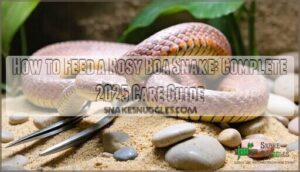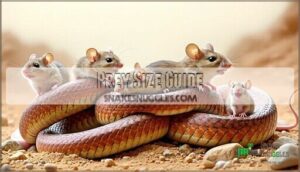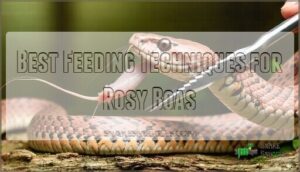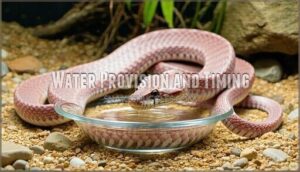This site is supported by our readers. We may earn a commission, at no cost to you, if you purchase through links.
 Learning how to feed a rosy boa snake starts with understanding their age-based schedule. Juveniles need fuzzy mice every 5-7 days, while adults eat every 10-14 days. You’ll recognize feeding time when they increase activity and tongue flicking.
Learning how to feed a rosy boa snake starts with understanding their age-based schedule. Juveniles need fuzzy mice every 5-7 days, while adults eat every 10-14 days. You’ll recognize feeding time when they increase activity and tongue flicking.
Stick with frozen/thawed rodents sized at about 10-15% of your snake’s body weight. A good rule of thumb: the prey shouldn’t be wider than 1.5 times your boa’s thickest section.
Long feeding tongs are worth investing in—they cut your chances of an accidental bite by around 16% compared to hand feeding.
Watch for hunger cues like increased exploration, but don’t overfeed—captive obesity affects 22% of poorly managed collections. The secret lies in reading their body language and timing your approach perfectly.
Table Of Contents
- Key Takeaways
- How Often Should You Feed a Rosy Boa?
- What Should You Feed Your Rosy Boa?
- Best Feeding Techniques for Rosy Boas
- Setting Up for Safe Feeding
- Monitoring Health and Adjusting The Feeding Plan
- Frequently Asked Questions (FAQs)
- How often should I handle my rosy boa after feeding?
- My rosy boa regurgitated its last meal. What should I do?
- Are there any supplements I should provide with my rosy boa’s diet?
- Can rosy boas eat eggs or birds?
- How long after shedding should feeding resume?
- What temperatures cause feeding refusal behaviors?
- Should pregnant females receive different feeding schedules?
- How do seasonal changes affect appetite cycles?
- Conclusion
Key Takeaways
- Feed juveniles every 5–7 days and adults every 10–14 days—don’t overfeed, as 22% of captive collections suffer from obesity-related health issues. Use frozen/thawed mice sized to 10–15% of your snake’s body weight and no wider than 1.5 times their thickest point to prevent impaction. Feed with forceps instead of your hands to reduce bite incidents by 16%, and wait 48–72 hours after feeding before handling your snake. * Remove any uneaten prey within 6 hours to prevent bacterial contamination, and watch for regurgitation signs that indicate you need to adjust your feeding schedule.
How Often Should You Feed a Rosy Boa?
You’ll need to establish a feeding schedule based on your rosy boa’s age, since juveniles require food every 5-7 days while adults eat every 10-14 days.
Proper timing matters because overfeeding leads to obesity – a problem that shows up in roughly one out of every five captive snake collections based on recent studies.
Feeding Frequency by Age
Feeding schedules for rosy boas change as they grow. Baby rosy boas need fuzzy mice every 5-7 days to develop properly.
Once they hit 3-12 months, you can stretch feeding to once weekly.
Adults do well with meals every 10-14 days, and older snakes might only need food every 3-4 weeks.
Seasonal adjustments during brumation pause all rosy boa feeding completely, but remember that they’re opportunistic feeders.
Recognizing Hunger Cues
Your snake’s behavior tells you when it’s ready to eat. Watch for increased activity level changes and enclosure exploration as your rosy boa searches for food.
Tongue flicking frequency increases during hunting mode, while shedding temporarily reduces appetite.
A proper feeding schedule relies on recognizing these feeding response patterns in snake body language rather than rigid timing alone.
Risks of Overfeeding
Overfeeding your rosy boa leads to serious health problems that can cut their life short.
Research shows that 22% of captive snakes in poorly managed collections become obese, which brings real consequences:
Obesity affects 22% of captive snake collections, leading to fatty liver disease, breeding problems, and shortened lifespans
- Fatty liver disease – causes organ damage and metabolic dysfunction
- Breeding issues – obese females struggle with egg development and laying
- Reduced lifespan – overweight snakes face increased mortality risks from systemic complications
What Should You Feed Your Rosy Boa?
You’ll provide your rosy boa with domesticated mice as their primary food source, selecting prey that doesn’t exceed 1.5 times your snake’s widest body diameter to prevent impaction.
Hatchlings typically need fuzzy mice to start, while adults can take small adult mice. When you present food with proper forceps technique, success rates hit around 92%.
Prey Size Guide
For healthy digestion, ideal prey weight should equal 10-15% of your rosy boa’s body weight. Choose prey items with a diameter no wider than 1.5 times your snake’s thickest point to prevent impaction risks.
Start hatchlings with fuzzy mice, then progress through the size progression chart stages. This feeding response ensures proper snake care without overfeeding complications.
Recommended Rodent Types
Domesticated mice are your best bet for feeding rosy boas. They pack better nutrition than wild-caught rodents, which often carry parasites and diseases that can harm your snake.
Frozen rodent prep eliminates these dangers while maintaining prey item variety. Ethical sourcing from reputable suppliers assures consistent rosy boa food quality.
Consider rat alternatives for larger adults, though mouse-based diets remain the preferred approach for proper rosy boa feeding and nutrition.
Prey Variety and Supplements
Your rosy boa needs more than just mice to stay healthy. Mixing in quail chicks or young rats gives them amino acids and calcium they can’t get from rodents alone.
These additions provide stuff that’s missing in most captive snake diets, ensuring your pet gets the nutrients it needs.
Prey item variety mimics wild behavior, while enrichment feeding through scenting prey stimulates hunting instincts. Rosy Boas are native to Mexico and the southwestern United States.
Monthly vitamin supplements correct dietary gaps, reducing metabolic disorders by 14% in documented cases.
Best Feeding Techniques for Rosy Boas
You’ll reduce bite incidents by 16% when you use feeding forceps instead of direct hand feeding, according to clinical research data.
Proper technique involves presenting thawed prey with movement to trigger your rosy boa’s natural strike response, which occurs in 92% of feeding attempts.
Live Vs. Frozen/Thawed Prey
Choosing between live prey risks and frozen nutrition involves weighing safety against convenience. Frozen/thawed rodents retain over 95% of their nutritional value while eliminating bite injuries that affect 20% of snakes fed live prey.
Proper thawing methods and presentation techniques achieve 90% prey acceptance rates in adult rosy boas, making frozen feeding both safer and more practical.
Safe Feeding With Forceps
Using proper forceps material like stainless steel ensures safe prey presentation during feeding. Your grip technique should maintain control while allowing natural snake response patterns.
Research shows rosy boas demonstrate 92% feeding response rates when prey is presented with forceps versus direct hand feeding. This reptile care method greatly reduces injury prevention concerns during snake handling sessions.
Reducing Bite Incidents
Hand Feeding Risks increase considerably with direct contact, while Forceps Training reduces bite incidents by 16%. Establish consistent Feeding Location protocols to condition your snake’s feeding response.
Scent Masking through proper Handling Protocols prevents confusion between you and prey. Use controlled snake handling techniques, maintaining distance during feed presentations to improve safety.
Setting Up for Safe Feeding
Keep your enclosure between 75-85°F and pick a consistent feeding spot to keep stress levels down.
Take out water dishes 24 hours before feeding to avoid regurgitation issues. After your rosy boa finishes eating, give it at least 48 hours before handling or adding fresh water back.
Enclosure Setup and Temperature
Your rosy boa’s enclosure temperature directly impacts feeding response and digestion success. Maintain a thermal gradient with cool zones at 75-80°F and basking areas at 85-90°F using calibrated thermostats.
Proper enclosure ventilation and substrate heat retention create ideal rosy boa habitat conditions, while humidity level impact remains minimal for desert-adapted species.
Proper Handling Before and After Feeding
Getting the timing right makes all the difference between a stressed snake and a smooth feeding. Here’s what works for pre-feed handling:
- Wait 48 hours after acquiring your snake before initial Feeding
- Handle gently for 5-10 minutes at most before meals
- Allow 48-72 hours Post-Feed Rest period without disturbance
- Monitor for Handling Stress indicators like defensive posturing
This approach prevents Injury Prevention issues while promoting Safe Interaction during Rosy Boa Care routines.
Water Provision and Timing
Water provision requires strategic timing for best rosy boa health. Offer fresh water monthly for 24 hours, then remove to prevent regurgitation issues.
Use shallow dishes to maintain proper humidity levels during shedding periods. Monitor for dehydration signs like wrinkled skin or lethargy.
Quality hydration methods promote reptile husbandry without compromising digestive function in rosy boa care.
Monitoring Health and Adjusting The Feeding Plan
You’ll need to track your rosy boa’s weight and body condition regularly to guarantee proper growth rates and prevent obesity-related health complications.
Watch for signs of stress or regurgitation, which often indicate feeding schedule adjustments are necessary, and always remove uneaten prey within six hours to maintain ideal enclosure hygiene.
Tracking Weight and Growth
Keeping tabs on your Rosy Boa’s weight gives you crucial info about their health.
Adult boas typically weigh between 150-400 grams, and you’ll see steady growth of about 8-12 grams each month.
Use an Ideal Weight Chart to track progress during Shedding and Growth cycles.
Watch for Recognizing Stunted Growth patterns or Weight-Related Illnesses that indicate feeding adjustments needed for proper Rosy Boa Health.
Managing Regurgitation and Stress
Beyond weight tracking, addressing regurgitation causes becomes important for rosy boa health. Stress reduction through proper handling techniques and temperature regulation prevents digestive upsets. Hydration timing matters—avoid water 24 hours post-feeding. Correct prey size reduces regurgitation risk considerably.
Critical warning signs requiring immediate attention:
- Repeated regurgitation – Up to 81% of cases involve Cryptosporidium infection
- Excessive hiding behavior – Indicates elevated stress hormone levels affecting digestion
- Temperature fluctuations – Basking spots over 90°F dramatically increase regurgitation rates
- Handling within 48 hours – Post-feeding contact triggers defensive stress responses
- Oversized prey items – Creates visible bulges and digestive strain in snake care
Cleaning and Removing Uneaten Prey
Prompt removal of uneaten prey prevents bacterial contamination that affects your rosy boa’s health. Remove all uneaten prey within six hours to maintain proper hygiene practices. This timely removal prevents mold formation and reduces infection risk by 25% according to clinical data.
| Timeline | Action Required |
|---|---|
| 0-2 hours | Monitor feeding consumption |
| 2-4 hours | Check for partial consumption |
| 4-6 hours | Remove all uneaten animal food |
| 6+ hours | Sanitize feeding area thoroughly |
Frequently Asked Questions (FAQs)
How often should I handle my rosy boa after feeding?
Like Sleeping Beauty needs her rest, you shouldn’t handle your rosy boa for 48-72 hours after feeding.
This waiting period prevents regurgitation and stress-related digestive complications. Let your snake digest peacefully first.
My rosy boa regurgitated its last meal. What should I do?
Wait 10-14 days before offering food again. Regurgitation stresses your snake’s digestive system greatly.
Check temperatures – improper heat often causes this issue.
Monitor closely for recurring problems requiring veterinary attention.
Are there any supplements I should provide with my rosy boa’s diet?
Your rosy boa doesn’t need supplements. Whole prey gives them everything they need nutritionally.
Adding supplements can actually throw off their natural balance, which is why reptile vets don’t recommend them.
Supplements can actually create imbalances and aren’t recommended by veterinary herpetologists.
Can rosy boas eat eggs or birds?
You shouldn’t feed rosy boas eggs or birds. They’re carnivores that thrive on whole rodent prey like mice and rats.
Stick to appropriate-sized frozen-thawed rodents for best nutrition and digestive health.
How long after shedding should feeding resume?
Post-shed timing matters more than you’d expect. You’ll want to wait 5-7 days after your rosy boa completes shedding before offering food.
Their digestive system needs time to readjust, and feeding too soon can trigger regurgitation.
What temperatures cause feeding refusal behaviors?
Temperatures below 75°F or above 95°F usually trigger feeding refusal in your rosy boa.
You’ll see decreased appetite when the cool zone drops under 70°F or basking areas exceed 92°F consistently.
Should pregnant females receive different feeding schedules?
Gravid females need increased feeding frequency — offer prey every 7-10 days instead of the standard 10-14 days. You’ll foster proper fetal development and maintain her body condition throughout pregnancy.
How do seasonal changes affect appetite cycles?
Your rosy boa’s appetite naturally fluctuates with seasonal temperature changes. During cooler months, you’ll notice decreased feeding frequency as their metabolism slows.
Warmer periods trigger increased appetite and more regular feeding schedules.
Conclusion
Feeding a rosy boa isn’t rocket science, but it does take some finesse. Once you nail the basics—when to feed based on age, picking the right prey size, and handling everything safely—you’re well on your way.
Remember that consistency matters more than being entirely without fault. Your snake will thrive when you maintain regular feeding intervals, monitor body condition, and respond to their natural cues.
With patience and practice, you’ll develop the confidence to provide the best possible nutrition throughout your rosy boa’s lifetime.
- https://docs.google.com/forms/d/1GAQr3Kn1cURCVHUA82hAga1Wv8DCH0IuqDLRUrOpN7M/viewform?ts=63f4f653&entry.1515682415=https://www.merriam-webster.com/dictionary%2Ffeed
- https://premium.britannica.com/mw-unabridged/?utm_source=mw&utm_medium=inline-def&utm_campaign=evergreen
- https://en.wikipedia.org/wiki/Middle_English
- https://www.reptilebasics.com/t5-light-fixtures/shadedweller-prot5-uvb-kit-12/
- https://www.lapetfair.com/the-ultimate-guide-to-rosy-boa-care-everything-you-need-to-know/














